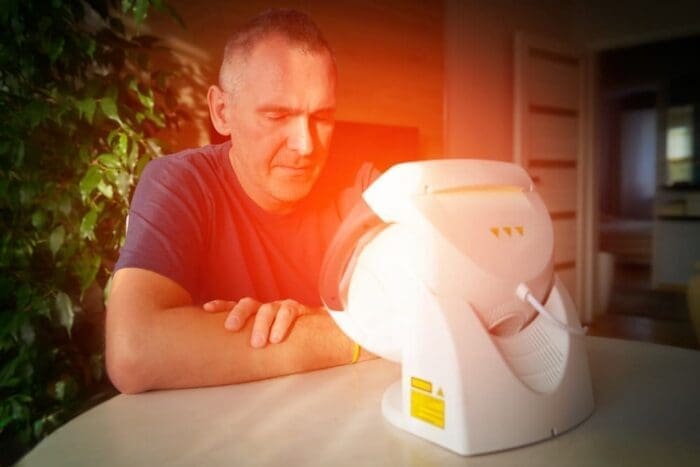In the world of health and wellness, light therapy is a rising star. This innovative method, which mimics natural outdoor light to modify your body’s circadian rhythms and suppress the natural release of melatonin, is attracting more and more followers. The goal is to boost mood, enhance sleep, and improve overall quality of life. The most common forms of light therapy are light therapy lamps and light therapy glasses. But to make an informed decision about which one is best suited for you, it’s important to understand what light therapy is, how it works, and how these two devices differ.
Understanding Light Therapy
What is Light Therapy?
Light therapy, also known as phototherapy, is a technique that involves exposure to intense levels of light under controlled conditions. The light used in light therapy must be a certain kind of white light, with an exposure of 10,000 lux of light and devoid of ultraviolet (UV) light. This is to ensure that the light is safe for your eyes and skin. Light therapy is usually conducted with the help of specially designed devices, such as light therapy lamps or light therapy glasses, which are designed to emit the appropriate intensity and type of light.
How Does Light Therapy Work?
The science behind light therapy is fascinating. It works by resetting your biological clock, also known as your circadian rhythm. This internal clock is responsible for regulating many of your body’s functions, including sleep and mood. When this clock is out of sync, it can lead to a host of problems, including sleep disorders, depression, and Seasonal Affective Disorder (SAD).
Light therapy is based on the principle that regular exposure to a specific intensity of light can help to recalibrate this clock, improving symptoms of these and other conditions. By exposing your eyes to intense light, you can trick your brain into thinking it’s earlier or later in the day than it really is, helping to reset your sleep-wake cycle and improve your mood.

Comparison Between Light Therapy Lamps and Glasses
Light Therapy Lamps
Light therapy lamps, also known as light boxes, are devices that emit full-spectrum light similar in composition to sunlight. These lamps are used indoors and require you to sit at a specific distance with the light directed at your eyes. Keep your eyes open and stay awake during therapy, but don’t look directly at the light.
The therapy usually lasts for about 20 to 30 minutes, and it’s recommended to do it first thing in the morning to help reset your circadian rhythm. However, the exact timing and duration can be adjusted based on your individual needs and the recommendations of your healthcare provider.
Light Therapy Glasses
Light therapy glasses, on the other hand, are wearable devices that emit a soft green light. Unlike the light therapy lamps, these glasses deliver light directly to the photoreceptive cells in your eyes, even when your eyes are closed. This makes light therapy glasses more convenient and less disruptive to your daily routine than light therapy lamps.
The glasses can be worn while you’re going about your usual activities, such as reading, working on a computer, or even cooking breakfast. Just like the lamps, the glasses are used primarily in the morning to help reset your circadian rhythm and improve your mood.
How to Choose the Right One for You
Choosing between a light therapy lamp and glasses depends on your lifestyle, convenience, and specific needs.
If you have a more sedentary lifestyle or spend most of your day in one location, a light therapy lamp might be more suitable. These lamps are easily portable and can be set up wherever you have access to a power outlet. They’re also a good choice if you prefer a more passive form of therapy, where you can sit and relax while the light does its work.
On the other hand, if you have a more active lifestyle and prefer a portable option, light therapy glasses might be the better choice. These glasses are small, lightweight, and battery-powered, so they can be used anywhere. They’re also a good choice if you want to continue with your normal activities while undergoing therapy.
Regardless of which device you choose, it’s important to consult with a health professional. They can provide individualized guidance based on your specific circumstances and health needs, ensuring that you get the most out of your light therapy sessions.


